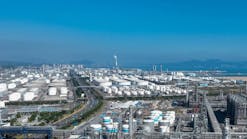EIA sees East Coast market pressure if another refinery closes
PBF Energy Co. LLC’s October 2011 startup of a previously idled Delaware City, Del., refinery has helped the New England oil products market respond to closures of ConocoPhillips’s Trainer refinery in September and Sunoco Inc.’s Marcus Hook facility in December, the US Energy Information Administration said. But Sunoco’s plans to close its remaining Philadelphia refinery in July could change the situation, EIA warned in a Feb. 27 report.
The 335,000-b/d facility accounts for nearly a quarter of the East Coast’s total refining capacity, EIA said. “If the Sunoco Philadelphia refinery shuts down in July 2012, suppliers may need to find 240,000 b/d of gasoline and 180,000 b/d of [ultra-low sulfur diesel fuel] by 2013 in addition to the amounts that have been supplied historically,” it said.
The ULSD gap won’t simply result from lost refining capacity, EIA added. It said New York State plans to require that heating oil meet the same low-sulfur rules as ULSD starting in July, effectively increasing ULSD demand by 70,000 b/d and annual ULSD demand in the Northeast by 20% on average, although the heaviest pressure will occur during the winter heating season.
The transition following the closures of the 185,000-b/d Trainer and 178,000-b/d Marcus Hook refineries has been relatively smooth so far because operations have resumed at the 182,200-b/d Delaware City facility, according to EIA. Product prices have climbed, largely in response to increasing crude oil costs, and impacts from Hovensa SA’s shutting down its 350,000-b/d US Virgin Islands facility in early February are beginning to be felt, it said.
“If Sunoco’s Philadelphia refinery closes in July 2012 as announced, the Northeast could be significantly impacted as the additional loss of volumes and reduced access to distribution systems may create temporary, localized shortfalls and associated price surges,” the report said.
Logistical constraints
It said adequate refining capacity outside the East Coast exists to replace the lost capacity, but logistical constraints on delivering products to some parts of the Northeast may present significant challenges in the short term. ULSD will be more difficult to replace than gasoline, it indicated.
“However, all replacement products will face difficulties moving through Pennsylvania and into western New York, which have historically received a major portion of their product supplies through product pipelines originating in the Philadelphia area refinery complex,” the report continued. “The industry may face significant logistical challenges in the Northeast for a year or more, as infrastructure changes will be necessary to accommodate replacement product flows.”
It said both pipeline and tanker constraints in moving products from the US Gulf Coast to the Northeast have to be overcome. “The pipeline that delivers products from the Gulf Coast to the Northeast is at or near capacity,” it said. “As a result, additional volumes will need to move from the Gulf Coast to the Northeast by water.” Shipments between two US ports require tankers that meet Jones Act requirements, and such vessels are chartered months in advance, limiting their short-term availability, the report said.
Receiving products at ports and connecting into pipelines from the Philadelphia area to inland Pennsylvania and western New York is a second logistical constraint, it indicated. “Unloading systems and related equipment that had been used for the receipt of crude oil at idled refineries require considerable modification before they can be used to receive products,” the report said. “Moreover, there is little or no connectivity from existing crude oil terminals to product pipelines at ports that have been receiving crude oil for use as a refinery input.”
Alternative sources
Global distillate fuel oil markets are structurally tight, particularly for ULSD, which many foreign refiners can’t produce, it said. “Thus, ULSD is likely to be sourced mainly from the US Gulf Coast, where ULSD exports have been growing, reaching over 500,000 b/d in recent months,” it said.
“Global availability of gasoline is greater than that of ULSD, and gasoline replacement volumes are likely to draw heavily from imports sourced in Europe and Asia, notably India,” the report continued. “However, refinery closures in Europe and the shutdown of the Hovensa refinery are tightening the global gasoline market. Import volumes can be shipped on foreign-flagged vessels, but they face the same terminal capacity and pipeline connectivity issues.”
It said the potential loss of Sunoco’s Philadelphia refinery presents a complex supply challenge, and no single solution will address the resulting logistical hurdles.
“The industry will have a financial incentive to serve all markets in the Northeast, and companies are currently investigating options,” it said. “However, companies are not likely to make significant investments in new logistical arrangements until the status of Sunoco’s Philadelphia refinery is known.”
EIA, which released the Feb. 27 report to update one it issued in December, said it would continue to monitor the situation as it evolves.
Contact Nick Snow at [email protected].

Nick Snow
NICK SNOW covered oil and gas in Washington for more than 30 years. He worked in several capacities for The Oil Daily and was founding editor of Petroleum Finance Week before joining OGJ as its Washington correspondent in September 2005 and becoming its full-time Washington editor in October 2007. He retired from OGJ in January 2020.


